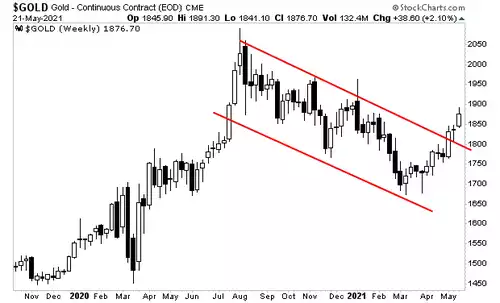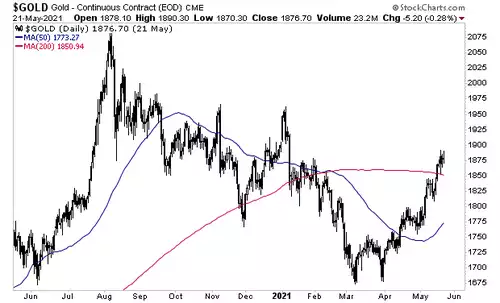Gold & Silver Rally on Reality
News
|
Posted 26/05/2021
|
8068
Both gold and silver had strong nights last night, both up around 1% whilst shares and USD all declined. As we wrote last week here, the AUD is dropping despite the USD dropping as well meaning we got all and more of those gold and silver gains last night in AUD.
Importantly too, gold broke through USD1900 and silver through USD28, adding key support for further gains. The 2 charts below show how technically gold has broken through the 9 months channel of consolidation and now through both the 50-day and 200-day moving averages.


So what is driving this price action? Frankly it is likely because even the most willfully blind can see the reality of what’s coming and they are seeking the trade that provides both protection and upside to its conclusion. Real Vision recently interviewed FFTT’s Luke Groman to get his take in the self explanatorily titled piece called “Why Inflation Will Not Be Transitory”… It’s a long piece so here is the crux:
- “the US economy is really in our view past the point of no return from a balance of payments perspective, at a time when foreigners, foreign central banks in particular, are not financing enough of US deficit. So we start to be governed by the balance of payments math that every other nation on the planet has long been governed by. And once you start applying that to the US situation, there's really one of two outcomes.”
- “You either get basically a deflationary collapse or you get a very secular structural inflation as the currency weakens. And our take is that when you look historically, very few sovereigns with a fiat currency have chosen collapse over inflation when given the choice, and the US clearly has the choice.”
- The US has chosen twice already:
1. On Monday we wrote about the REPO stress happening now (and getting worse since) and that of September last year. Gromen writes: “we had a choice to finance treasuries at 8%, but the Fed chose to print the money to get repo rates back down.”
2. “And again, last March of course, in the COVID crisis we had the choice to let the economy collapse. The Fed chose to implement QE at $625 billion per week and then slowed it from that point.”
- In response to the ‘transitory’ calls off the back of the speed of the reflationary response and the interruption to supply chains being seen before, he points out that now is very different:
- “What they're leaving out is the context for where we are. We're not at 55% debt to GDP in the United States like we were in 1995. We're not at 65% like we were in 2000. We're not at 80% or 75% like we were in '09, we’re at 130% debt to GDP.”
- “US entitlements are cash flow negative and getting more cash flow negative by the day unlike being cash flow positive all those other times.”
- “The US government is 22% or 25% of GDP, way above where we were in these other recoveries. Transfer payments as of personal consumption expenditures, so consumer spending is 35%. So a third of the consumer spending, which itself is 2/3 of GDP is coming straight from the government. They're just shifting it from one pocket to each other.”
- And the most important structural contextual difference he says is this is the first recovery in 80 years where foreign central banks are not buying US Treasuries on net, and haven’t since 2014.
- What that means is a complete change to the holder of the world’s reserve currency and the ‘privilege’ that came with it. Simply - “Historically, the way the world worked is, people sent us stuff and we sent people dollars and then they reinvested those dollars in the US, which it meant we exported treasuries. They sent us stuff we sent them treasuries. And they're still sending us stuff, but we're not sending them treasuries anymore because they don't want them. They're not buying enough.” We wrote of this recently in the ‘twin deficit’ issues the US currently faces.
- “And so what you end up with is basically the US government being beholden to the same balance of payments math as everybody else. And once that happens the question is, OK, do we shrink the government? But if you shrink the government at 25% of GDP you go into a recession. If you go into a recession with debt to GDP at 130%, the treasury market collapses. There's not enough private sector balance sheet to float the increase in treasuries that happens in a recession with debt already this high, with foreigners not buying, with the dollar where it is. So any recession is a non-starter, you can't have it. Because the Treasury market will break and the Fed has repeatedly said, we're not going to let the Treasury market rate.”
- Groman goes on to state he does not thing the Fed can ‘dial’ it down a little. At a debt to GDP of 130% it is a switch not a dial. They are stuck. To be able to dial it down they first need to get that figure down to around 80%. To do that would take 20% GDP growth for 5 years. To do that inflation has to rip higher. He sees no other way out.
- That ultimately means deeply negative real rates “To me, the biggest misperception on Wall Street today-- by far and away, in my view-- is that real rates in the United States bottomed in August of last year at negative 1.1% on the 10 year. I think they are going to at least negative 5% to negative 10%. And I think they could go lower than that, quite possibly. And I think they need to go lower than that. I think that's what the government wants to de-cover their balance sheet. So let's assume that I'm right, that it goes to negative 10% on the real rate, what do I want to own? I think you want to own gold, gold miners, Bitcoin, commodities.”